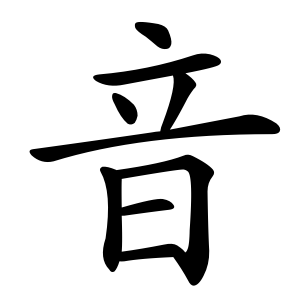音
- sound, noise;
Etymology
音 (음, “sound”) does not appear in oracle bone script (甲骨文, jiǎgǔwén) but begins to appear in bronze inscriptions (金文 jinwen).
It is classified as an ideogram and is formed by inserting 一 (a horizontal stroke) inside 口 (mouth) from the character 言 (speech). The character etymologically represents sounds that come out through speech, which is why in seal script (篆書, zhuànshū), its shape was nearly identical to 言. However, by the time of the regular script (楷書 kǎishū), the forms had diverged.
In 言, the upper component 䇂 (허물 건) transformed to resemble 亖 (a variant of 四, “four”), while in 音, the 䇂 component lost its bottom vertical stroke instead. This difference marks how the two characters evolved differently despite their close origins.
Usage in Korean
When 音 (음) is used as a semantic radical, it generally conveys meanings related to sound, voice, or music.
音 can refer not just to sound and voice, but also to human pronunciation. It’s used in classifying consonants into the five sound categories:
아음 (牙音) – velar (back of tongue) sounds
설음 (舌音) – tongue sounds
순음 (唇音) – lip sounds
치음 (齒音) – dental (teeth) sounds
후음 (喉音) – throat sounds
It is also used to denote regional pronunciations, such as 秦音 (Qin pronunciation). For example, in Korean, it’s difficult to pinpoint the exact region or era of influence due to ongoing changes over time, but in Japanese, Chinese readings of kanji are still categorized into Kan-on (漢音), Go-on (吳音), and Tō-on (唐音) based on the period and region of borrowing from Chinese.
Although 音 and 聲 (sound, voice) are similar in meaning, they differ in nuance:
音 generally refers to musical sounds or instrumental sounds,
聲 refers to vocal sounds made by the human vocal organs.
In the classic Chinese dictionary Shuowen Jiezi (説文解字 shuōwén jiězì), the character 音 appears in examples of:
오성 (五聲) – the five musical notes: 宮, 商, 角, 徵, 羽.
팔음 (八音) – the eight types of musical instruments: 絲, 竹, 金, 石, 匏, 土, 革, 木.
Since there are not many Chinese characters pronounced “음” in Korean, 音 was used in idu or gugyeol systems to mark syllables ending in the/m/ sound, such as in “다짐”, which could be written as 侤 音. This explains why 音 appears frequently in the few surviving hyangga (향가), mostly to represent that final/m/ sound.
Additional notes
- 卜廿日 (YTA)
- ⿱ 立 日
- ⿱ 亠 𣅑
